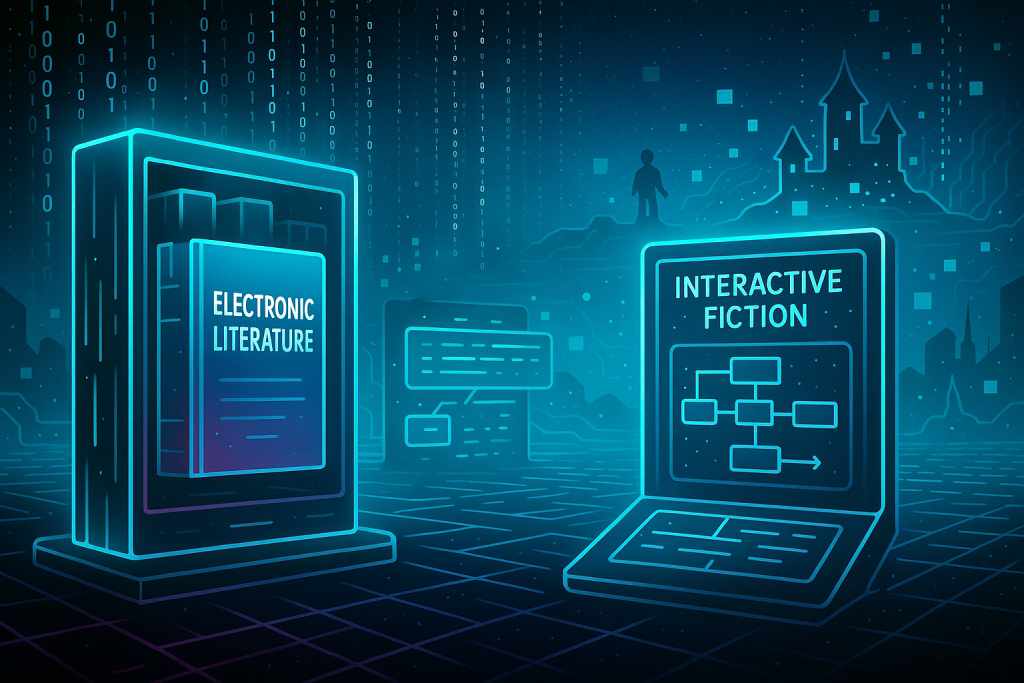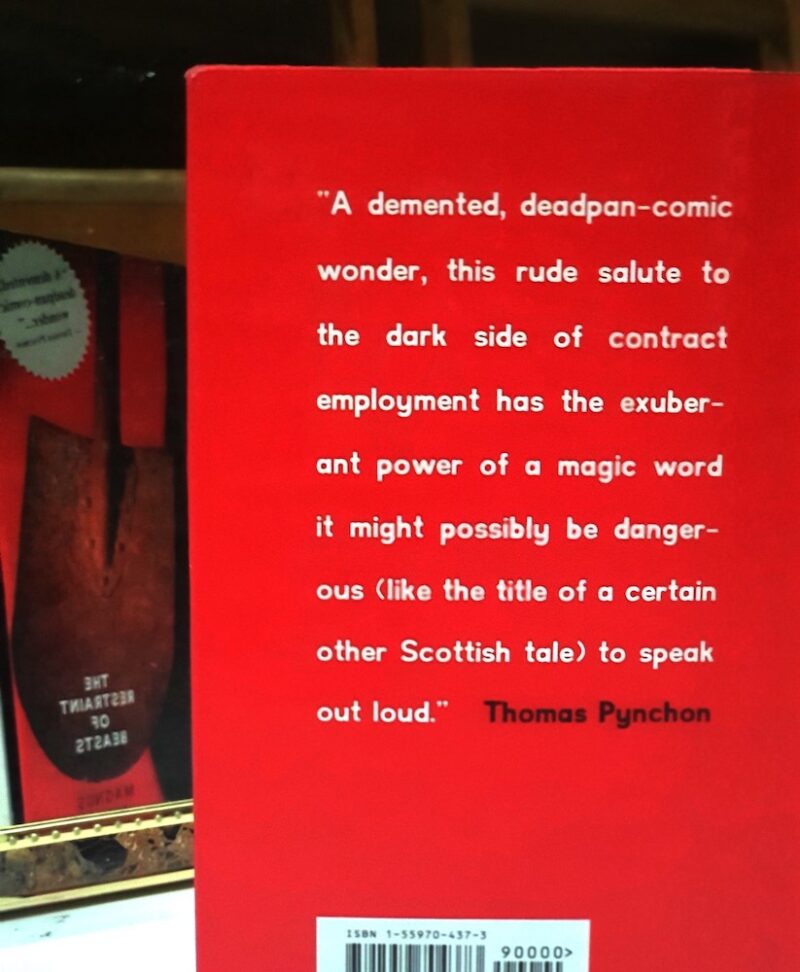Electronic literature refers to literary works that originate within digital environments and rely on computational processes for their creation, distribution, or interpretation. These works are not simply digitized versions of print texts but are conceived specifically for digital contexts. They draw from the distinctive features of digital media such as code, interactivity, multimedia layering, and networked frameworks to construct forms of textual engagement that would be impossible in print.
Electronic literature’s connection to interactive fiction is foundational rather than peripheral, as both arose from programmable environments where language behaves less like a static vessel and more like an active system. In both, the written word is not confined to narration but are responsive, mutable, and embedded entities within structures that explore or even demand manipulation. The outcome is not a story alone, but a set of possibilities emerging from the fusion of human input and computational logic.
Forms and Functions of Electronic Literature
Electronic literature encompasses a wide variety of digital-born works, including hypertext fiction, generative literature, code poetry, kinetic text, and algorithmic storytelling. Its formal range defies simple classification, but its defining characteristic lies in the inseparability of medium and text. The work does not merely reside in the words on screen but in their behavior, in how they move, evolve, respond, or refuse to respond.
Electronic literature is not a genre but a mode of composition and engagement. In works like Jason Nelson’s This is How You Will Die (2006), a slot machine interface produces unpredictable death scenarios, and merges black humor with procedural generation. In Stuart Moulthrop’s Reagan Library (1999), links multiply into an immersive system of disorientation, and construct experience through misdirection and recursive loops.
Hypertext Fiction: The Roots of Branching Narrative
Hypertext fiction represents one of the earliest and most influential forms of electronic literature. Structured through links rather than linear pagination, these works facilitate navigation between lexia (discrete units of text), resulting in unique reading paths and interpretive sequences.
Michael Joyce’s Twelve Blue (1996) offers an archetype of this structure: its subtle, disjointed vignettes break from chronological order, and reveal stories of loss, longing, and identity through associative, nonlinear movement. Yet more recent examples, such as Kaitlyn Ensley’s All the Delicate Duplicates (2017), integrate 3D environments, sound design, and spatial navigation, and further unmoor the textual experience from the static screen, pulling it into immersive digital space.
Hypertext fiction reconfigures authorship and reception. It asks not only what story is told, but how it may be assembled—and whether assembly itself constitutes an act of co-creation.
Interactive Fiction: Texts That Talk Back
Interactive fiction differs by introducing structured decision-making. Rooted in early parser-based games like Zork (1977), it has matured into a form where narrative progression depends on reader input. Unlike hypertext, which offers pre-determined branching paths, interactive fiction often incorporates logic, memory, and conditional response so that stories advance through action, discovery, and feedback.
Porpentine Charity Heartscape’s With Those We Love Alive (2014) is a clear example of this evolution. Built using Twine, it mixes interactive choices with poetic language, a looping structure, and even physical engagement, and asks the user to inscribe sigils on their skin. The body becomes part of the fiction, a gesture far from metaphor.
Whereas traditional fiction presents a closed narrative, interactive fiction constructs a provisional architecture, one where each input leads to new configurations, failed paths, or alternate consequences.
Generative Literature: Code as Authorship
Generative literature relies on algorithmic processes to produce text. Rather than writing a single work, the author creates a system capable of generating multiple iterations or versions, often with varying degrees of coherence or intelligibility. The result can be surprising, disjointed, rhythmic, or even uncanny.
In Taroko Gorge (2009), Nick Montfort programmed a poem generator that renders infinite stanzas inspired by a natural scene. Subsequent remixes, such as Scott Rettberg’s Tokyo Garage (2010), retained the underlying structure while modifying its semantic register. Here, the authorial role shifts from composing lines to scripting the conditions for language production.
Generative literature reveals a tension between intent and randomness. It opens literature to procedural logic and machine output, where meaning arises not solely from authorial design but from rule-based emergence.
Electronic Literature and the Question of Interaction
Degrees of Interaction
Not all electronic literature places control in the hands of the reader. Some works operate as kinetic texts, such as YHCHI’s Dakota (2002), an animated poem whose motion is pre-scripted and presented as a visual explosion of words, sound, and tempo. Others permit selective manipulation without granting full agency, forming a spectrum rather than a binary between static and interactive.
Interaction as Reading Practice
Interaction alters the role of the reader. In print literature, turning the page is mechanical. In electronic literature, advancement may require solving a puzzle, selecting from conflicting choices, or decoding embedded code. The reader becomes a participant in meaning-making not just interpretively but structurally.
Distinctions and Overlaps: Electronic Literature vs. Interactive Fiction
While all interactive fiction can be considered a subset of electronic literature, not all electronic literature is interactive fiction. The distinction rests on narrative intent and input structure. Interactive fiction privileges story progression through interaction, often modeled as a game or simulation. Electronic literature may dispense with narrative entirely by prioritizing form, language behavior, or aesthetic gesture.
In Talan Memmott’s Lexia to Perplexia (2000), for example, the work fuses cybernetic jargon and poetic syntax by offering a hybrid of code and text that resists story altogether. Its interactivity is minimal, but its structure and effect are irreducibly digital.
The Future of Digital Literary Forms
As machine learning and artificial intelligence (AI) advance, new forms of generative literature are emerging, such as GPT-powered fiction or collaborative storytelling platforms that mix algorithmic generation with user-driven revision. The distinction between author, machine, and reader is becoming increasingly hazy.
Recent experimental platforms like AI Dungeon or LitRPG narratives that incorporate real-time user commands into long-form storytelling demonstrate that electronic literature remains a fertile ground for invention not just technologically but also conceptually.
Electronic literature redefines what it means to write and read by embedding the literary impulse within computation. From hypertext’s linked labyrinths to generative poetry and parser-based fiction, it rethinks narrative control, reader participation, and the materiality of language in computational environments.
While interactive fiction forms a crucial strand of this lineage, the full scope of electronic literature extends far beyond interactivity, encompassing text that transforms, mutates, or self-produces within the circuitry of the medium. Its significance lies not in technological novelty but in its persistent challenge to fixed forms, static authorship, and passive consumption.
Further Reading
Electronic literature on Wikipedia
Introduction to Electronic Literature by Nasrullah Mambrol, Literariness.org
Genres of Electronic Literature on asukane.wordpress.com
Reflections on Reading, Learning via Electronic Literature by Mia C. Zamora, Connected Learning Alliance




